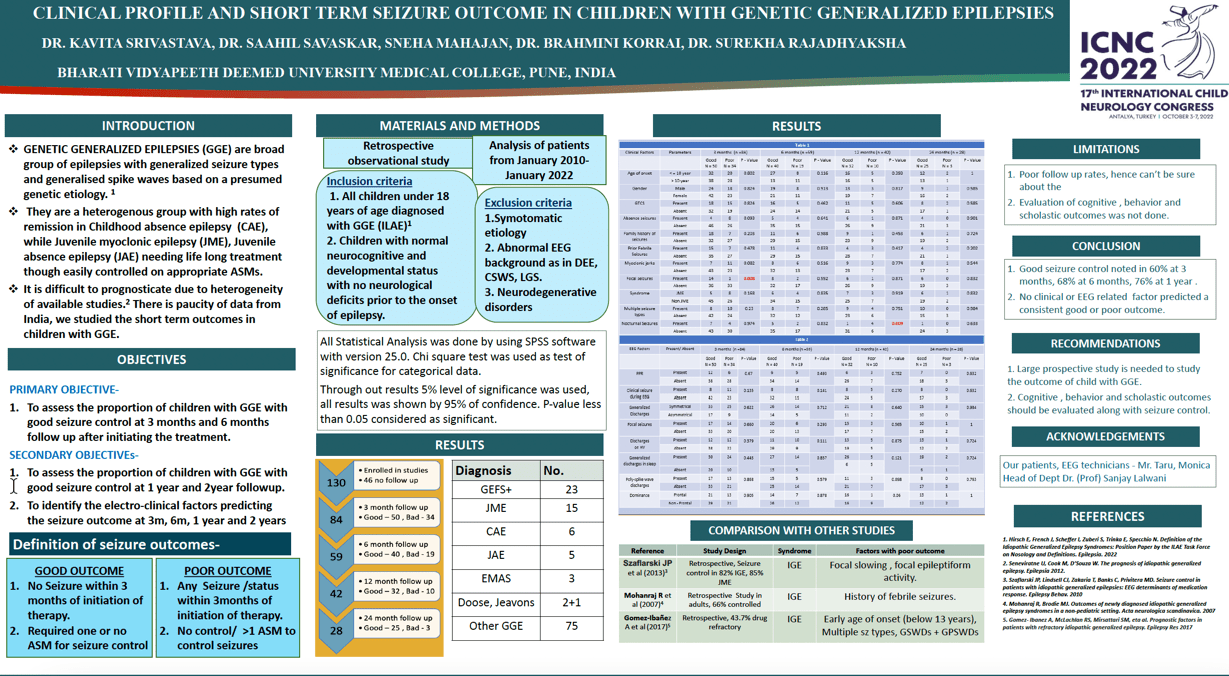Clinical profile and short term seizure outcome in children with Genetic Generalized Epilepsies
Kavita Srivastava, Saahil Savaskar, Sneha Mahajan, Surekha Rajadhyaksha
Introduction- GGE are defined as a group of generalized epilepsies (ILAE, 2017) .We conducted this study to look for seizure control at 3 months after initial diagnosis. Methods- All children less than 18 years, diagnosed with GGE were enrolled. The seizure outcome at three months follow-up was considered good if no recurrence. Results- From January 2010 till January 2022, 156 patients were diagnosed with GGE, out of which 89 patients were available for follow up at 3 months. Seizure control was poor in 22 patients (24.7%) at 3 months followup. Age of onset was below 10 years in 58% (poor outcome in 23%) while remaining 42% had onset after 10 years (poor outcome in 27%). 51 (57%) were males-19.6% had poor outcome, while 43% were females- 29% had poor outcome. Most common syndrome was IGE (51) followed by JME (11), JAE (11), CAE (7), GEFS+ (6), EMA (2) and Jeavons (1). Amongst IGE group- 8%, JME-27%, JAE- 18%, CAE-29% had poor outcome. 56 (63%) were on monotherapy, while 28 (31%) were on polytherapy. Family history was present in 16 (18%), only 1 child had poor outcome while 73 children (82%) did not have any family history- 20 children (27%) had poor outcome. Conclusion- Amongst genetic generalized epilepsies, 25% do not have good short term seizure control outcome. Factors like age of onset of seizures, gender did not influence the outcome. Family history of seizures seemed to be protective and needs to be confirmed in larger studies.
Keywords: genetic generalised epilepsies, GGE, IGE, outcome, seizure
Kavita Srivastava
Bharati Vidyapeeth University Medical College, Pune, India
India
Saahil Savaskar
Bharati Vidyapeeth University Medical College, Pune, India
India
Sneha Mahajan
Bharati Vidyapeeth University Medical College, Pune, India
India
Surekha Rajadhyaksha
Bharati Vidyapeeth University Medical College, Pune, India
India
Introduction- GGE are defined as a group of generalized epilepsies (ILAE, 2017) .We conducted this study to look for seizure control at 3 months after initial diagnosis. Methods- All children less than 18 years, diagnosed with GGE were enrolled. The seizure outcome at three months follow-up was considered good if no recurrence. Results- From January 2010 till January 2022, 156 patients were diagnosed with GGE, out of which 89 patients were available for follow up at 3 months. Seizure control was poor in 22 patients (24.7%) at 3 months followup. Age of onset was below 10 years in 58% (poor outcome in 23%) while remaining 42% had onset after 10 years (poor outcome in 27%). 51 (57%) were males-19.6% had poor outcome, while 43% were females- 29% had poor outcome. Most common syndrome was IGE (51) followed by JME (11), JAE (11), CAE (7), GEFS+ (6), EMA (2) and Jeavons (1). Amongst IGE group- 8%, JME-27%, JAE- 18%, CAE-29% had poor outcome. 56 (63%) were on monotherapy, while 28 (31%) were on polytherapy. Family history was present in 16 (18%), only 1 child had poor outcome while 73 children (82%) did not have any family history- 20 children (27%) had poor outcome. Conclusion- Amongst genetic generalized epilepsies, 25% do not have good short term seizure control outcome. Factors like age of onset of seizures, gender did not influence the outcome. Family history of seizures seemed to be protective and needs to be confirmed in larger studies.
Keywords: genetic generalised epilepsies, GGE, IGE, outcome, seizure
Kavita Srivastava
Bharati Vidyapeeth University Medical College, Pune, India
India
Saahil Savaskar
Bharati Vidyapeeth University Medical College, Pune, India
India
Sneha Mahajan
Bharati Vidyapeeth University Medical College, Pune, India
India
Surekha Rajadhyaksha
Bharati Vidyapeeth University Medical College, Pune, India
India

Kavita Srivastava
Bharati Vidyapeeth University Medical College, Pune, India India
Bharati Vidyapeeth University Medical College, Pune, India India